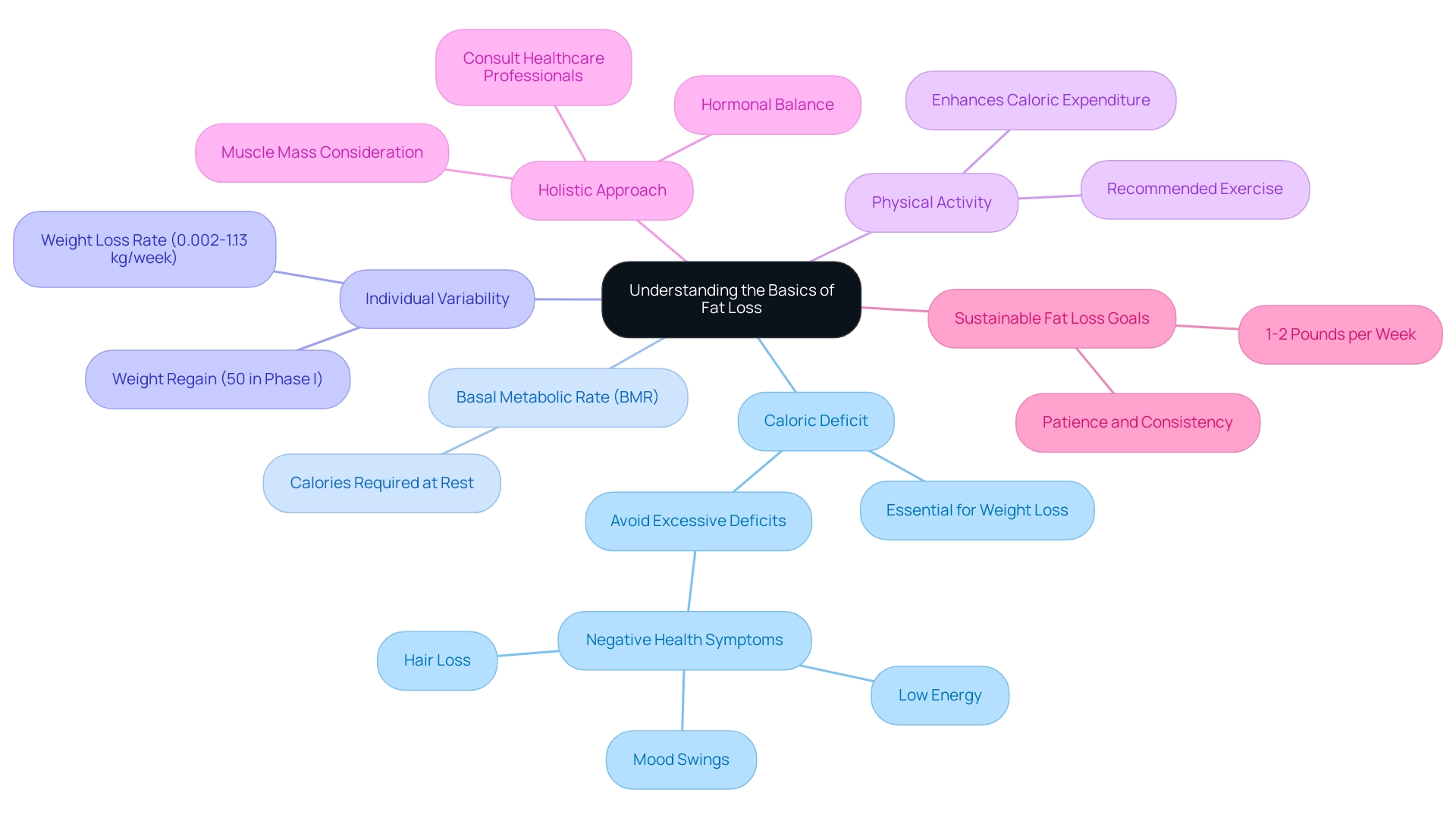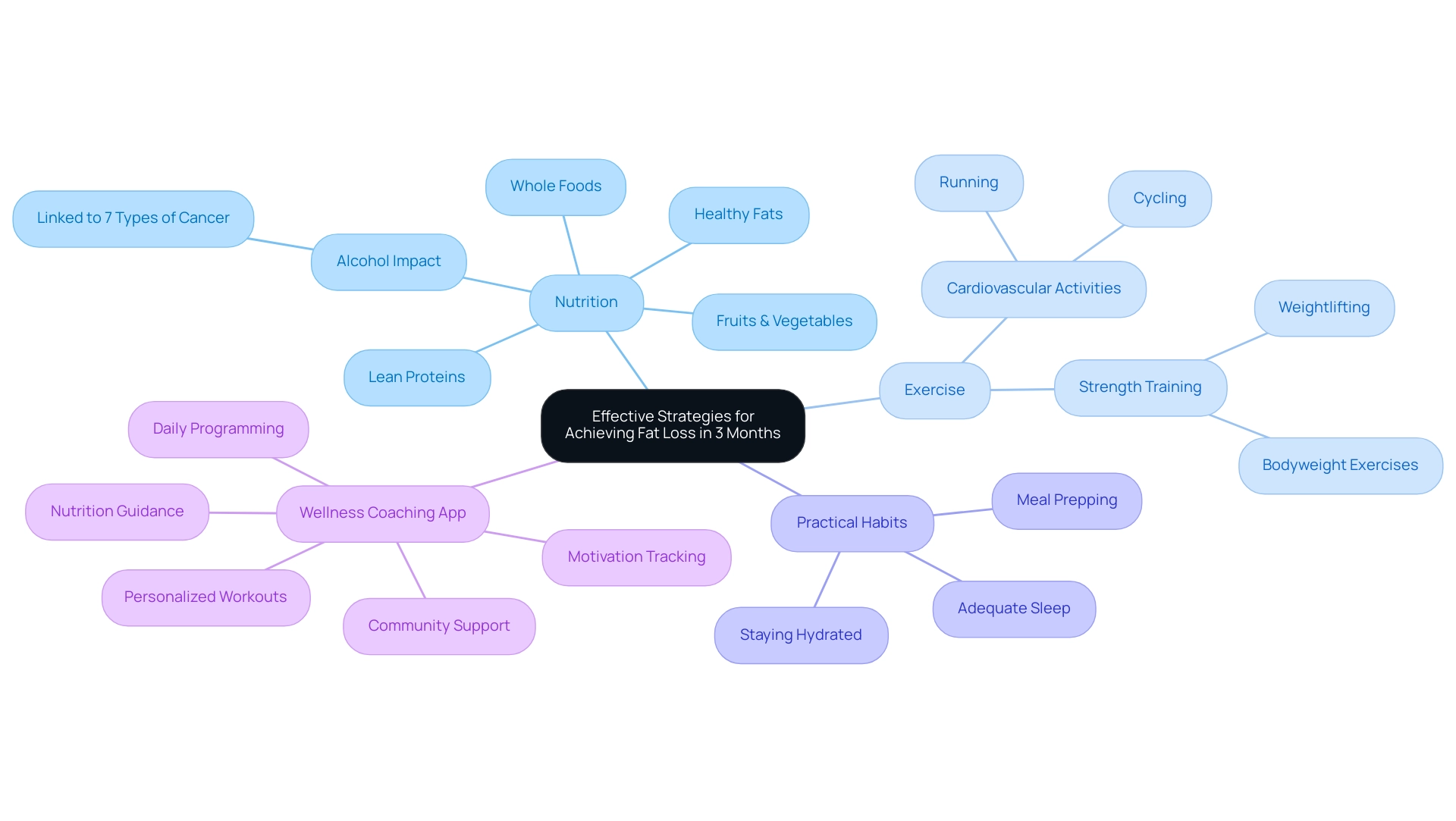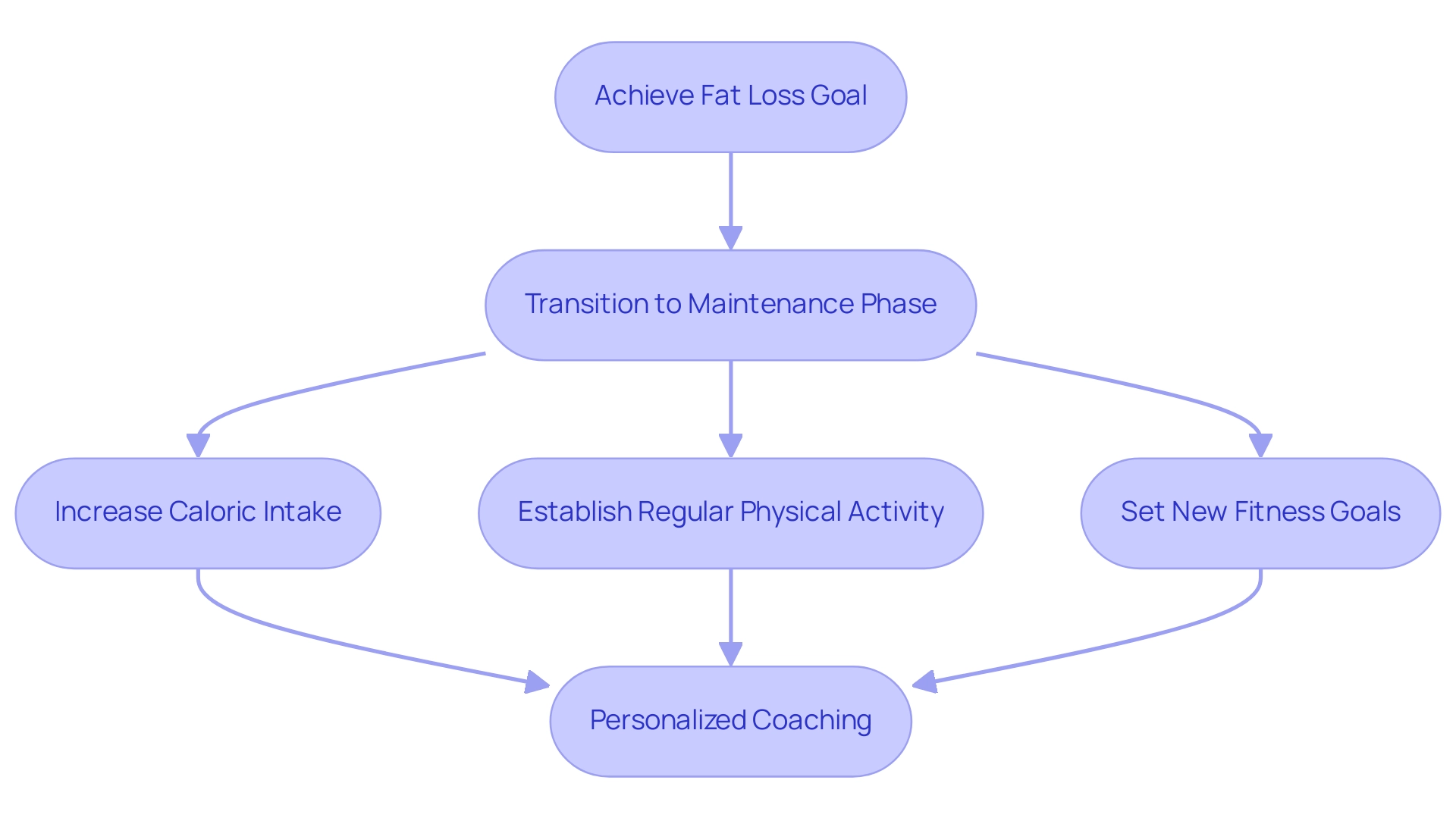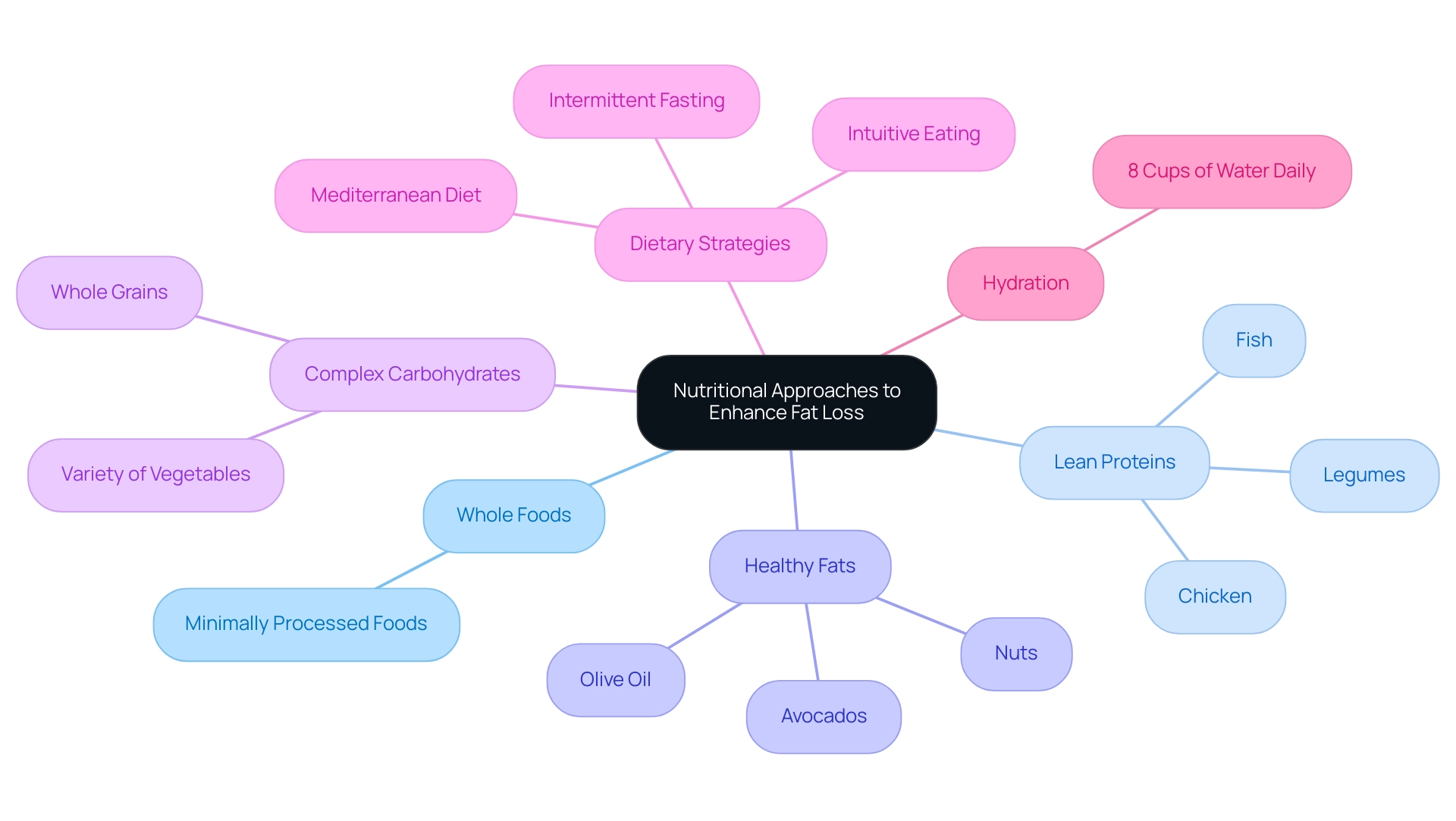Overview
To achieve fat loss within three months, individuals must create a caloric deficit through a balanced nutrition plan and regular physical activity, aiming for a sustainable reduction of 1 to 2 pounds per week. The article emphasizes that this approach should incorporate whole foods, strength training, and tailored support to ensure long-term success and prevent common pitfalls like unrealistic expectations and overly restrictive diets.
Introduction
In the quest for fat loss, understanding the intricacies of nutrition and exercise is paramount. This journey requires more than just cutting calories; it demands a comprehensive approach that encompasses:
- Sustainable habits
- Mindful eating
- A commitment to physical activity
With the right strategies in place, individuals can not only achieve their weight loss goals but also maintain them long-term. This article delves into the fundamental principles of fat loss, effective strategies for achieving results within three months, and the critical importance of maintenance phases. It also addresses common pitfalls to avoid and offers nutritional approaches that can enhance fat loss. By fostering a culture of health and wellness, both individuals and teams can embark on a transformative journey toward improved well-being.
Understanding the Basics of Fat Loss
Achieving 3 month fat loss fundamentally hinges on creating a caloric deficit, where the calories burned exceed those consumed. A pivotal factor in this equation is understanding your basal metabolic rate (BMR)—the number of calories your body requires at rest to maintain essential functions. Research highlights that the rate of reduction in mass observed can vary significantly, with studies indicating a range of 0.002 to 1.13 kg per week, as noted by Research Associate Marie-Pierre St-Onge.
This underscores the variability in individual responses to dietary changes. Furthermore, physical activity plays a crucial role in enhancing overall caloric expenditure, making it a vital component of any strategy for 3 month fat loss.
However, fat reduction is not merely a matter of reducing caloric intake; it encompasses a holistic approach that considers hormonal balance, muscle mass, and metabolic health. At Foresight Health Coaching, we offer comprehensive health coaching services, including personalized fitness coaching and tailored nutritional guidance designed to meet the unique needs of both individuals and corporate teams. Our wellness workshops further empower participants with the knowledge and strategies necessary for sustainable fat loss.
Our corporate memberships cater to groups of up to 30 employees, with the flexibility to adjust for additional members.
These memberships include in-person wellness talks, comprehensive pantry and nutrition services, and access to our exclusive health and wellness app, ensuring that your team has the support they need for optimal health. The latest findings from ongoing studies emphasize the necessity for tailored dietary approaches, particularly those that resonate with specific demographic preferences. It’s important to note that, on average, participants in weight reduction studies regained only half the weight shed in Phase I, highlighting the challenges of maintaining 3 month fat loss and the significance of sustainable strategies.
As you set objectives, aim for a sustainable reduction in fat of 1 to 2 pounds each week to achieve a 3 month fat loss. This realistic timeline fosters patience and consistency—key allies in your journey towards improved well-being.
Remember, while a caloric deficit is essential, it is crucial to avoid excessive deficits that can lead to adverse health symptoms, such as low energy and mood swings, as illustrated in case studies. Consulting with healthcare professionals, like those at Foresight, can ensure a balanced approach, ultimately supporting a healthier path to weight reduction.
Together, we can craft a wellness plan that truly suits your needs and the health of your team. Contact us today to learn more about our corporate memberships and how we can assist in your wellness journey.

Effective Strategies for Achieving Fat Loss in 3 Months
To achieve effective 3 month fat loss, it is essential to prioritize a balanced nutrition plan rich in whole foods, lean proteins, healthy fats, and an abundance of fruits and vegetables. This approach is supported by research connecting low-calorie density eating plans to enhanced food quality and a lowered risk of various diseases. Notably, dietary choices are crucial, as alcohol has been linked to seven types of cancer, according to the U.S. Surgeon General.
Combine this dietary strategy with a structured exercise regimen that includes both cardiovascular activities—such as running or cycling—and strength training, like weightlifting or bodyweight exercises, at least 3-5 times each week to achieve your 3 month fat loss objectives. Our wellness coaching app enhances this plan by providing personalized workouts and nutrition guidance tailored to each individual's needs, all conveniently accessible in one place.
As noted by Sassos, 'The flexibility makes it more sustainable in the long run,' highlighting the importance of adaptable dietary habits. Additionally, consider implementing practical habits like meal prepping to curb impulsive eating, staying hydrated, and ensuring adequate sleep to support recovery and hormonal balance. It is important to avoid overly restrictive diets, as illustrated by the raw food diet case study, which was rated last among the 30 best overall diets due to its restrictive nature.
With features like daily programming, video demonstrations, direct messaging for personalized coaching, and community support, tracking your progress through our app fosters accountability and boosts motivation, empowering you to encourage your team in pursuing their health goals.

The Importance of Maintenance Phases in Fat Loss
Reaching your goal of 3 month fat loss is an impressive achievement, but the journey doesn't end there. Transitioning into a maintenance phase is essential for ensuring that your hard work pays off in the long run. This phase involves gradually increasing your caloric intake to a sustainable level that preserves your body mass while allowing for flexibility and enjoyment in your meals.
Personalized coaching plays a crucial role here, providing tailored guidance that empowers individuals to make lasting lifestyle changes. One client, Jane D., shared, "With my coach's support, I not only shed pounds but learned how to keep it off while enjoying my favorite foods." Regular physical activity should become a permanent aspect of your lifestyle, not just a temporary endeavor.
In fact, studies, such as those by Coleman et al., show that achieving 150 minutes of moderate-vigorous physical activity (MVPA) per week can lead to significant improvements in fitness levels, reinforcing the importance of staying active during maintenance. Setting new fitness goals—like enhancing your strength or endurance—can reignite your motivation and keep your health journey exciting. As coach Mark S. emphasizes, "Using evidence-based techniques like progressive overload and interval training, we tailor workouts to keep clients engaged and challenged."
It's crucial to regularly reassess your objectives and adjust your strategies to maintain progress and satisfaction. Moreover, the Institute of Medicine emphasizes that very-low-calorie meal plans (VLCDs) are not suitable for all overweight individuals and are typically restricted to those with a BMI greater than 25. While VLCDs can facilitate rapid reduction in body mass, their effectiveness in a 3 month fat loss plan diminishes without a solid maintenance strategy and continuous engagement.
Many individuals struggle to sustain their results after returning to regular eating habits. A case study on VLCDs emphasizes that although these diets can result in significant short-term reduction, long-term maintenance of body mass is difficult and often necessitates medical oversight. Thus, finding joy in the process, aligning your efforts with your personal values, and seeking experienced coaching are vital for successful long-term management of your health.

Avoiding Common Mistakes in Your Fat Loss Journey
Navigating the journey of achieving 3 month fat loss can be challenging, as many individuals fall into common pitfalls that hinder their progress. One of the most prevalent mistakes is setting unrealistic expectations. When individuals anticipate quick outcomes, they frequently turn to excessively limiting meal plans, which may result in short-term loss but can ultimately have negative consequences.
A balanced approach is key; instead of cutting out entire food groups, focus on integrating nutritious whole foods into your diet, which are naturally harder to overconsume. As highlighted in a study, "individuals who logged their food once per day lost 0.63% more of their body weight each month than those who logged meals once per month." This highlights the significance of consistent monitoring in achieving objectives for 3 month fat loss.
Moreover, it's crucial to recognize the vital role of strength training in achieving 3 month fat loss. Many individuals incorrectly prioritize cardio while overlooking strength training, which can lead to muscle reduction and a slowed metabolism. Instead, adopting a well-rounded fitness routine that includes resistance training can enhance fat reduction, supporting 3 month fat loss by preserving muscle mass and boosting metabolic rate.
Additionally, skipping meals or drastically cutting calories can instigate cravings and lead to binge eating, undermining your efforts. It's essential to acknowledge that highly processed foods can contribute to overeating, making it vital to prioritize whole food options. Remember, consistency trumps perfection—allowing yourself occasional indulgences can foster a healthier relationship with food and prevent feelings of deprivation.
Furthermore, understanding common errors in assessing fat reduction strategies is crucial. For instance, in randomized controlled trials, researchers sometimes use inappropriate methods that can lead to erroneous conclusions about treatment effects. This emphasizes the significance of utilizing suitable techniques in evaluating fat reduction strategies.
Embrace these strategies, and motivate your team to adopt a balanced lifestyle that prioritizes both physical health and well-being.

Nutritional Approaches to Enhance Fat Loss
To achieve rapid fat reduction effectively and support a 3 month fat loss, prioritize a diet abundant in whole, minimally processed foods. Emphasize the inclusion of lean proteins—such as chicken, fish, and legumes—alongside healthy fats like avocados, nuts, and olive oil. Incorporating complex carbohydrates from sources such as whole grains and a variety of vegetables will further support your goals.
Implementing strategies such as intermittent fasting can be a game-changer, as it has been shown to enhance fat reduction significantly. Notably, recent studies indicate that sprint interval training helps individuals lose nearly 40% more body fat while requiring much less time than traditional high-intensity interval training (HIIT). Additionally, Ju Young Kim from the Department of Family Medicine at Seoul National University Bundang Hospital highlights that the VLCKD program is recommended for severe obesity and related conditions, underscoring the importance of a structured dietary approach.
To provide a concrete example, the Mediterranean diet emphasizes high intake of fruits, vegetables, poultry, fish, and dairy, with little red meat, and has shown strong evidence for weight reduction and improvements in cardiometabolic parameters. Furthermore, practice intuitive eating by being mindful of portion sizes and tuning into your body's hunger cues. Staying hydrated is particularly important; aim for at least 8 cups of water daily, as this can help control hunger and boost metabolic function.
By adopting these nutritional strategies, you not only pave the way towards 3 month fat loss but also foster a culture of health and wellness within your team.

Conclusion
Achieving fat loss is a multifaceted journey that requires dedication to sustainable habits, mindful eating, and a commitment to regular physical activity. By understanding the basics of caloric deficits and the importance of a balanced diet, individuals can create a solid foundation for their fat loss goals. Incorporating a variety of whole foods, engaging in both cardio and strength training, and maintaining realistic expectations are crucial steps in this process.
As individuals work towards their goals, the significance of maintenance phases cannot be overstated. Transitioning to a maintenance phase allows for the gradual adjustment of caloric intake while promoting a lifestyle that values flexibility and enjoyment. This phase is where the real transformation occurs, ensuring that the efforts made are not just temporary but lead to lasting change.
Moreover, avoiding common mistakes—such as setting unrealistic expectations and neglecting strength training—can greatly enhance the likelihood of success. Embracing a balanced approach to nutrition and exercise, while also recognizing the importance of mental well-being, fosters a healthier relationship with food and fitness.
Ultimately, the journey of fat loss is not just about numbers on a scale; it is about cultivating a culture of health and wellness that empowers individuals and teams alike. By prioritizing these principles, everyone can embark on a transformative path toward improved well-being, ensuring that the strides taken today lead to a healthier tomorrow.




